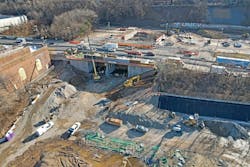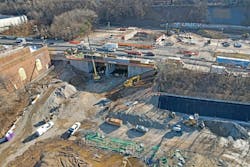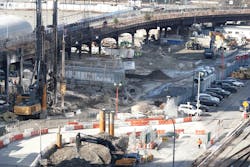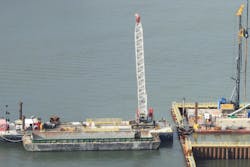Hudson Tunnel Project on Track to be Completed by 2035
In November 2023, construction began on the Hudson Tunnel Project, one of the largest infrastructure projects in U.S. history.
The Hudson Tunnel project consists of three components:
- The construction of a two-track Hudson River rail tunnel between Bergen Palisades in New Jersey and New York Penn Station in Manhattan, N.Y.
- The building of the third and final segment that will enable the new Hudson River Tunnel to connect into New York Penn Station.
- Rehabilitation of the existing North River Tunnel, which sustained significant damage during Superstorm Sandy in 2012.
The end goal of the massive project is to provide long-term resiliency and reliability for the regional and national rail network for New Jersey Transit and Amtrak riders.
In 2019, the states of New York and New Jersey created the Gateway Development Commission (GDC) as a special purpose entity to build the projects of the Gateway Program, which includes the Hudson Tunnel project. Projects for the GDC are assigned by the governors of New York and New Jersey. The GDC is made up of a seven-member board, with members representing the states of New York and New Jersey, as well as Amtrak. GDC is currently the exclusive project sponsor for the Hudson Tunnel Project.
Project scope and timeline
According to GDC Chief of Public Outreach Steve Sigmund, the Hudson Tunnel project comes down to the replacement of four tubes:
- The creation of two new rail tubes under the Hudson River for the first time in 115 years.
- The full rehabilitation of the existing one track in and one track out of the North River Tunnel.
Once the massive project is completed, the hope is the infrastructure will last for a century or more. Sigmund says the massive project is 10 miniature projects combined into one. Currently, three of the 10 miniature projects are under construction.
The project started with the Tonnelle Avenue Bridge and Utility Relocation in New Jersey, which will provide access to the entry point for tunnel boring machines that will dig the New Jersey portion of the new Hudson River Tunnel and connect the two portions of the Tonnelle Avenue Staging Site, which is the primary staging site for the project. This project is expected to conclude in fall 2025.
In New York, work has also started on the Hudson Yards Concrete Casing, Section 3 project, which will build the third and final segment that will enable the new Hudson River Tunnel to connect into the New York Penn Station. Work on the project is expected to be completed in 2026.
Heavy construction on the Hudson River Ground Stabilization project started in the summer of 2024. This project helps stabilize Manhattan’s side of the riverbed to allow the tunnel boring machines to excavate while protecting the riverbed ecosystem. Weeks Marine, Inc., was awarded the contract for the project in February. Phase one of the project included surveying, as well as design and construction of a test cofferdam to various levels of kinds of soil creep that were being created to stabilize the ground. Phase two kicked off this past fall and involves injecting grout into the silt that makes up 1,200 feet of shallow riverbed on the eastern side of the Hudson River.
In February 2025, GDC awarded the $1.18 billion contract for the Manhattan Tunnel Project to Frontier-Kemper-Tutor-Perini JV. The project, which is expected to be completed by 2029, will build the section of the new Hudson Tunnel Project tubes from the Manhattan Bulkhead in the Hudson River to the cut-and-cover Hudson Yards Concrete Casing east of 12th Ave. The project will also remove obstructions that could slow or damage the tunnel boring machines digging the portion of the tunnel passing under the Bulkhead and into Manhattan and will protect and support existing features, including the Bulkhead and sewer lines.
In a statement to Mass Transit magazine, Weeks Marine, Inc. Project Manager John Kelly said, “The team at Weeks Marine is thrilled to have the opportunity to apply our expertise to the first heavy construction contract on the Hudson Tunnel Project. We are making great progress on riverbed stabilization and will continue to work closely with GDC to clear the way for tunneling under the Hudson.”
Sigmund says the Hudson River Ground Stabilization Project is one of the key components to ensure the tunnel stays upright.
“The natural consistency of the bottom of the river is sort of like chocolate pudding, and if you didn't do anything there, then [the bottom of the river] would get churned up and collapse onto the tunnel, and you wouldn't have a stable base for the tunnel to get through to get to Manhattan,” Sigmund said.
Sigmund notes work cannot be completed on the Hudson River Ground Stabilization Project between the months of January and June due to a fish window in a certain section of the river.
“During those months, there’s sturgeons, which are these giant, dinosaur-like fish that get as long as like 14 feet, and they spawn, and they go through that section of the river, and they’re protected,” Sigmund said.
The Palisades Tunnel Project is the first tunnel boring project of the Hudson Tunnel project and consists of two separate tunnels – each approximately 5,100-feet long and with an inside diameter of 25 feet, two inches. This project focuses on constructing the first mile of the twin tunnels on the New Jersey side of the Hudson River. Construction on the project began in 2024 after the GDC awarded a contract to Schiavone Dragados Lane JV. The project is expected to be completed by 2027.
In a statement to Mass Transit magazine, Schiavone Construction Co. LLC’s Director of Engineering and Special Projects Andrejs Delle said, “Launching the first tunnel boring machines through the Palisades will be a watershed moment for the most urgent infrastructure project in the country. Schiavone Lane Dragados JV is proud to be responsible for delivering the first mile of the new tunnel in New Jersey. We will be all-hands-on-deck, from the Palisades Tunnel groundbreaking through completion.”
Sigmund explains why the Palisades Tunnel Project is one of the most complicated parts of the entire Hudson River Tunnel project.
“Before doing anything on that project, we had to acquire the easements to over 200 properties that sit on top of the Palisades, which is anywhere from 80 to 250 feet above where we're going to be digging because each of the property owners on those properties owns their property. So if you're going under their property, even if you're 250 feet below their property and they won't feel a thing or know anything about it, you have to buy an easement from them, and you have to notify them,” Sigmund said.
Sigmund goes on to explain the tunnel boring process itself is not an easy one.
“You can't use some old boring machine unless it happened to have matched up exactly with that diameter, which none ever do,” Sigmund noted. “You also have to have a very specific drill bit depending on what kind of rock you're going through. In this case, it's a pretty hard shale. Each of the boring machines has to be constructed separately, and they have to be constructed from the time the contract is awarded; and it takes a good year for them to actually be constructed and shipped and ready to be here.”
Federal funding
GDC has secured the entire $16.3 billion needed to complete the project, with funding support coming from multiple sources:
- $6.9 billion from the Federal Transit Administration’s Capital Investment Grants Program
- $3.8 billion from the Federal Railroad Administration’s Intercity Passenger Rail Grant Program
- $2.7 billion from the Port Authority of New York and New Jersey
- $1.3 billion from the state of New York
- $1 billion from Amtrak
- $308 million from the state of New Jersey
- $292 million from the National Infrastructure Project Assistance (Mega) Grant Program
- $25 million from the Rebuilding American Infrastructure with Sustainability and Equity discretionary grant program
According to Sigmund, one of the reasons the project took so long to get off the ground is because the GDC had to demonstrate to the federal government the need for the entire scope of the project. Sigmund notes that although it took years to receive the funding, the timing of the project could not have worked out better.
“We had an administration and a White House and a Congress and a Department of Transportation and [Federal Railroad Administration] and [Federal Transit Administration] that were all aligned in supporting the project. And you had a historic Bipartisan Infrastructure Law that freed up and created funding for projects like this that had never existed before. So putting all that together in that two year kind of Goldilocks window was something that we worked very hard to do,” Sigmund noted.
When asked about whether the new Trump administration could cause concern when it comes to funding the project, Sigmund notes the project is fully funded, and that all projects take time and go through multiple leadership changes at local and national levels from the start to the completion of projects.
Effect on the economy
The project is expected to add a boost to the local and national economy, including creating more than 95,000 direct, indirect and induced jobs over the project’s construction period. The project is expected to generate $19.6 billion in economic activity over the construction period.
Sigmund notes the amount of effort being put into the massive project is to ensure riders can get from place –to place between the two states safely for decades to come, but that the project will also affect the U.S. economy in a big way.
“This is a conduit that is the choke point on the entire Northeast Corridor between Boston and Washington [D.C.], which is the most important economic corridor in the entire country,” Sigmund said. “It accounts for 20 percent of the nation's economic output. It's a $22 billion hit to property values. It's 30 minutes more commuting a day in the most congested area in the country already and two million more tons of carbon in the air, over an already overheated atmosphere.”
Next steps
The GDC is moving forward with the second phase for the Hudson River Ground Stabilization Project (HRGS) contract and is preparing for tunnel boring machine activity. GDC anticipates the HRGS Project will be completed by 2028, with a new tunnel in service by 2035.
Tonnelle Ave Bridge and Utility Relocation project
- Purpose: Create a new roadway bridge carrying Tonnelle Avenue over the future tunnel’s right of way, provide tunnel boring machine access to the entry point for digging the new Hudson River Tunnel and connect the two portions of the primary staging site for the Hudson Tunnel Project.
- Estimated construction completion: 2025
Hudson Yards Concrete Casting Section 3 project
- Purpose: Link the new Hudson River Tunnel to New York Penn Station.
- Estimated construction completion: 2026
Hudson River Ground Stablization project
- Purpose: Stabilize the riverbed to enable the start of tunnel boring and protect the river ecosystem.
- Estimated construction completion: 2027
Manhattan Tunnel Project
- Purpose: Build the section of the new Hudson Tunnel Project tubes from the Manhattan Bulkhead in the Hudson River to the cut-and-cover Hudson Yards Concrete Casing east of 12th Ave.
- Estimated construction completion: 2029
About the Author
Brandon Lewis
Associate Editor
Brandon Lewis is a recent graduate of Kent State University with a bachelor’s degree in journalism. Lewis is a former freelance editorial assistant at Vehicle Service Pros in Endeavor Business Media’s Vehicle Repair Group. Lewis brings his knowledge of web managing, copyediting and SEO practices to Mass Transit Magazine as an associate editor. He is also a co-host of the Infrastructure Technology Podcast.




